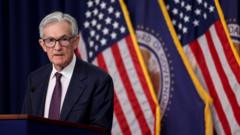In its latest announcement, the Fed maintained the key interest rate at 4.3%, reflecting a cautious approach amidst changing economic signals and outside pressures.
Fed Keeps Interest Rates Steady Amidst Economic Concerns and Tariff Changes

Fed Keeps Interest Rates Steady Amidst Economic Concerns and Tariff Changes
The Federal Reserve remains steadfast on interest rates despite economic forecasts signaling slower growth and rising unemployment.
The Federal Reserve made a significant announcement on Wednesday, opting to keep its key interest rates unchanged for the fourth consecutive time, despite mounting economic concerns. The benchmarks remain at 4.3%, the same level since December, as officials navigate a complex landscape shaped by recent policy changes and economic forecasts that hint at slower growth and an uptick in unemployment.
The decision comes as inflation rates continue to hover above the Fed's 2% target, with recent figures indicating a 2.4% rise in May. Typically, the Fed adjusts borrowing costs as a response to economic conditions; they tend to lower rates in times of economic struggle and raise them when inflation is on the rise. However, President Donald Trump has consistently urged the Fed to decrease interest rates, arguing that current economic pressures should prompt action.
Still, Fed officials assert their commitment to making decisions grounded in data rather than political influences, emphasizing the need for further information about how tariffs and policy changes may affect both inflation and the economy. Current projections from the Fed show a declining growth expectation of 1.4% for this year, a drop from a prior forecast of 1.7%. Meanwhile, inflation estimates have increased from 2.7% to around 3%, and the unemployment rate is expected to rise to 4.5%.
In response to criticism from Trump regarding Fed Chair Jerome Powell, who the President dubbed "stupid," economics experts suggest that Trump's pressure may complicate the Fed's decision-making process. Investment manager Isaac Stell noted that central bankers value their independence highly, and thus may resist cutting rates without a compelling reason.
As the Federal Reserve's interest rate policies define the cost of borrowing across various sectors, including mortgages and business loans, maintaining the current rate highlights their cautious strategy amid the ever-changing economic landscape. This involves weighing the delicate balance between stimulating growth and curbing inflation—trends that could evolve rapidly in the coming months as they monitor ongoing developments related to tariffs and international economic pressures.
The decision comes as inflation rates continue to hover above the Fed's 2% target, with recent figures indicating a 2.4% rise in May. Typically, the Fed adjusts borrowing costs as a response to economic conditions; they tend to lower rates in times of economic struggle and raise them when inflation is on the rise. However, President Donald Trump has consistently urged the Fed to decrease interest rates, arguing that current economic pressures should prompt action.
Still, Fed officials assert their commitment to making decisions grounded in data rather than political influences, emphasizing the need for further information about how tariffs and policy changes may affect both inflation and the economy. Current projections from the Fed show a declining growth expectation of 1.4% for this year, a drop from a prior forecast of 1.7%. Meanwhile, inflation estimates have increased from 2.7% to around 3%, and the unemployment rate is expected to rise to 4.5%.
In response to criticism from Trump regarding Fed Chair Jerome Powell, who the President dubbed "stupid," economics experts suggest that Trump's pressure may complicate the Fed's decision-making process. Investment manager Isaac Stell noted that central bankers value their independence highly, and thus may resist cutting rates without a compelling reason.
As the Federal Reserve's interest rate policies define the cost of borrowing across various sectors, including mortgages and business loans, maintaining the current rate highlights their cautious strategy amid the ever-changing economic landscape. This involves weighing the delicate balance between stimulating growth and curbing inflation—trends that could evolve rapidly in the coming months as they monitor ongoing developments related to tariffs and international economic pressures.




















